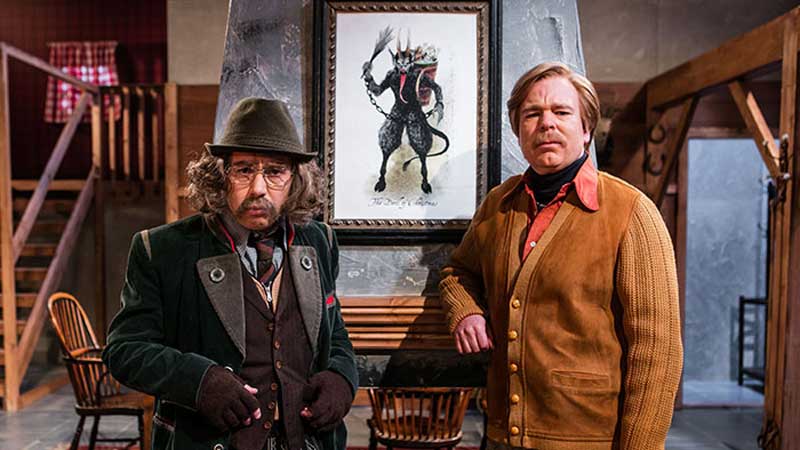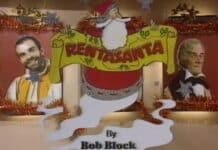CHRIS NEWTON says Inside Number 9’s The Devil of Christmas adds a dark twist to your normal Christmas TV fare…

When the dark comedy anthology series Inside Number 9 was announced back in 2013, writers Reece Shearsmith and Steve Pemberton cited Roald Dahl’s Tales of the Unexpected and Armchair Thriller among its’ influences. Whilst they were predominantly referring to the story-of-the-week nature of those programmes, these influences are taken to a much more literal extreme in their 2016 Christmas Special, The Devil of Christmas.
Our protagonists are the typical 1970s white, middle class English family so prevalent in the aforementioned shows. Julian, his mother Celia, son Toby and new – much younger – wife Kathy are spending Christmas in a snowy alpine chalet. (Number 9, naturally.) As they are shown around their holiday home by Klaus, the Austrian landlord, everything from the received pronunciation, wardrobe choices and wooden acting to the use of Ikegami HK 323 cameras (which would have been used in a 70s TV studio), creates so perfect a recreation of the classic teleplays of the late 70s – early 80s, it could almost pass for a genuine production of that era.
That is, of course, until Klaus (Shearsmith) is pointing out a painting of ‘Krampus’, the titular Devil of Christmas, (who is, incidentally, a real demon of Bavarian folklore who punishes children on Santa’s naughty list) when the tape is suddenly paused, and we hear what appears to be a directors’ commentary.
Director, Dennis Fulcher (Derek Jacobi), laments a continuity error regarding the placement of the painting in a style that echoes the deliberate gaffes of Garth Marenghi’s Darkplace.
Meanwhile, in the episode itself, the characters drink gluhwein (or watered-down Ribena, Fulcher complains) as Klaus regales them with the local legend. On the first night, bad children will find Krampus has left a switch (a bundle of twigs) in their shoe, on the second they will find he has marked their skin, and, if their mischievous ways are not mended by the third night he will come and drag them to Hell.
As you can imagine, little Toby awakes the following day to find a switch in his boots, and has mysterious scratch marks on his chest the next. Kathy grows more and more fraught, whilst Julian’s blasé dismissal of these horrors is nothing short of hilarious, the patronising, misogyny of the dialogue matched only by Pemberton’s superbly impassive delivery. “Maybe it was one of the locals trying to scare the gullible tourists.”
The terrified wife / dismissive husband dynamic is reminiscent of the lead characters in Baby, the terrifying episode of another classic British anthology show, 1976’s Beasts. The wives in both stories are newlywed, pregnant and fearing for the life of their unborn child after being disturbed by a local superstition.
When Kathy becomes hysterical (the incredible Jessica Raine hamming it up to perfection), insisting that Toby is about to be taken away by Krampus, Pemberton delivers the best line of the episode as Julian dispassionately chides “Kathy, calm down, you mustn’t excite yourself.”
This is followed by the least realistic slap you have ever seen. It’s tear-jerkingly funny, and almost warrants rewinding and watching again immediately, but for the intervention of the director asking for an “even angrier” take. “Toby, get dressed. We’re leaving!” Pemberton yells in a voice that could almost be Harvey Denton’s.
We’re a good three quarters into the episode by this stage and, whilst I’m enjoying it almost too much, I can’t help but shake the niggle that I’m enjoying it solely because of my nostalgia for the shows of which it is so obviously a pastiche. I can’t help but wonder what modern audiences will make of it, and whether or not the story beneath the wobbling sets and bad acting is actually any good. I think that, overall, it is, and the deliberate low budget is passable given that there are no special effects as such, and most of the scares are psychological. The going-to-bed-then-waking-up-to-find-something-scary aspect is almost Paranormal Activity-esque. That is until Krampus himself arrives, looking like a bad rubber monster from classic Doctor Who.
But this is, of course, Inside Number 9, where things are never as they seem, and I have been a fool to judge it prematurely. (Beware – here be spoilers!)
The Devil of Christmas Spoiler Alert!
The dodgy- costumed Krampus turns out to be just that, a man in a monster suit. Klaus, to be precise. Or Simon, as he is revealed to be without his false moustache and cod-Austrian accent. Simon is Kathy’s lover, and she is pregnant with his baby, not Julian’s. The whole Krampus-haunting has been a rouse to literally scare Julian to death.
At the sight of Simon in his demon costume, he suffers a fatal heart attack, leaving Kathy to claim the life insurance. (All of which is explained in a stilted monologue which is all exposition and no emotion.) It would be easy to dismiss Jessica Raine’s talents here, but anyone who’s seen her elsewhere (Doctor Who fans will recognise her as Emma Grayling from 2013’s Hide, and Verity Lambert in the Mark Gatiss dramatisation An Adventure in Time and Space.) will know she is a terrific actress, and whilst her performance here is wooden, it’s so believably wooden that it only adds to the authenticity of the episode. It’s not easy being this bad.
Kathy offers Simon a glass of celebratory champagne, but he is more interested in tying her to the bed for what she takes to nothing more than kinky fun. “Who’s Simon?” He asks, advancing menacingly. “I’m Krampus!”
And here the episode takes a genuinely horrific turn. It’s safe to say that, episodes of Inside Number 9 usually end up end up with most, if not all, of the main characters dead, but this is by far the darkest, and most disturbing the show has ever dared. A plastic sheet is spread on the bed beneath the actress playing Kathy, who is gagged against her will, and we discover that what we are watching is real. Suddenly the episodes’ low budget and amateurish style become its’ most terrifying aspect.
This film was never supposed to have any artistic merit, it’s just footage of a woman being murdered. The commentary we have been listening to is not a DVD extra, but a recording of a police interview with Fulcher. It’s here that Raine’s previously stiff acting pays off, and as she screams and squirms with such palpable terror, the contrast is so believable that it’s almost uncomfortable to watch.
It’s a classic Number 9 twist, worthy of Roald Dahl himself, and one I didn’t see it coming a mile off for the nostalgic misdirection. This is a truly great piece of television that works on many levels, but if you’re looking for Christmas cheer, this isn’t the show for you. We shouldn’t be surprised. After all, this is series who’s first episode centred around child abuse and ended with all but one of the characters being burned alive.
It took me by surprise on first viewing because I was too busy laughing for the first twenty-nine minutes, but that’s Inside Number 9 for you: you never know what’s coming next. I genuinely haven’t a clue what to expect from the upcoming fourth series (which wrapped earlier this year), but I can guarantee it will be unmissable.
Watch The Making of The Devil of Christmas
What did you think of Number 9’s The Devil of Christmas? Tell us in the comments section below!










I watched this on your recommendation – I loved it. The ending still has me creeped out!
I had to rewind the unrealistic slap many times – it had me in stitches! Great review. Makes me want to watch this episode again. In fact, makes me want to watch the whole series again.